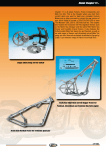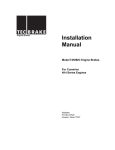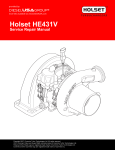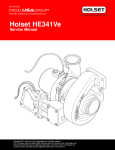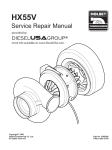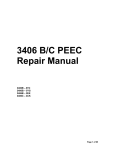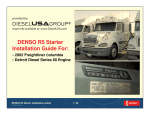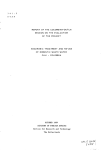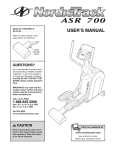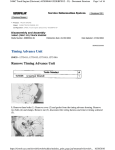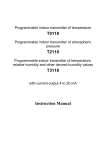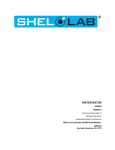Download Installation Manual
Transcript
brought to you by: DIESELUSAGROUP® get more at www.DieselUSA.com Engine Brakes Installation Manual Model T346A Engine Brakes For Caterpillar 3406, 3406B And 3406C Series Engines TecBrake P.O. Box 27822 Houston, Texas 77227 get more info at: www.DieselUSA.com Recommended Torque Values Bridge Adj. Screw lock nuts24 lbft (32 N*m) Cylinder Head Bolts330 lbft (450 N*m) Engine Brake Hold-down nuts100lbft (135 N*m) Engine Brake 7/16” cap screws60lbft (82 N*m) Rocker Arm Adj. Screw nuts22 lbft (30 N*m) Slave Piston Adj. Screw nuts16 lbft (22 N*m) Fuel Lines30lbft (41 N*m) INSTALLATION MANUAL TECBRAKE MODEL T346A ENGINE BRAKE FOR CATERPILLAR 3406, 3406B AND 3406C SERIES ENGINE SECTION 1-INTRODUCTION SECTION 2 - ENGINE PREPARATION The TecBrake T346A engine brake may be installed on Caterpillar model 3406, 3406B and 3406C series engine. These engines although similar, were produced with variations that affect the components required and the installation procedure. NOTICE The TecBrake Engine Brake is designed as a device for slowing a vehicle, not stopping it. It is to be used in conjunction with, but not a substitute for the vehicle’s service brakes. The service brakes must be in good operating condition and used to bring the vehicle to a complete stop. Material Required Figure 2-1 The TecBrake kit includes all of the parts required to make an installation on the most common engine configurations. An optional shim & washer kit (Part No. TJ013677) is required on all engines with a serial number lower than 7FB39279, or with a 92U prefix. This is not included with the engine brake kit and must be ordered separately. Refer to the identification plate on valve cover for required data. 1. Thoroughly clean engine before beginning installation. Remove all engine components necessary to permit access to cylinder heads. The TecBrake kit does not contain a control group. Five different control groups are available to cover all applications. These groups must be ordered separately in addition to the basic kit. Refer to the TecBrake Parts Manual for additional information. Special Tools Figure 2-2 The following special tools are required for installation: 1. 2. 3. 4. TecBrake Tools Feeler gage-0.080” Feeler gage-0.067” Feeler gage-0.060” Feeler gage-0.090” 1. 2. 3. 4. 5. Caterpillar Tools Caterpillar P/N. Fuel Line Socket-Flank Drive 3/4” 5P144 Fuel Line Wrench-7/8” 5P5195 Timing Pin-Fuel Pump (3406) 8S2291 Timing Pin-Fuel Pump (3406B) 6V4186 Turning Tool 9S9082 2. Remove the upper valve covers. TecBrake P/N. TB900005 TB900006 TB900004 TJ018488 Figure 2-3 3. Remove the valve cover base. 1 get more info at: www.DieselUSA.com NOTICE Follow procedure specified below to set engine to cylinder No.1 T.D.C. compression. This procedure will allow three cylinders to be adjusted for both valves and engine brakes without rotating the engine. One additional rotation to cylinder No 6 T.D.C. compression will be required to adjust the other three cylinders. 6. Insert timing bolt in location shown and rotate engine using the Caterpillar Turning Tool counter clockwise (looking from the flywheel side of the engine) until the timing bolt is aligned with the threaded hole in the flywheel. When the timing bolt can be threaded into the tapped hole in the flywheel, the engine is at T.D.C. cylinder No. 1. Look at both valves on cylinder No. 1 to see if they are both closed. If closed, cylinder No. 1 is on the compression stroke. If not, remove the timing bolt and rotate the engine 360 degrees until the timing bolt is aligned with the thread in the tapped hole. Timing Bolt Method to obtain T.D.C. Figure 2-4 Figure 2-7 4. From just above the starter, remove the timing bolt from its storage location and the access plate to the flywheel. 7. Check both rocker arms on cylinder No. 1 to make sure there is clearance by moving the rocker arms up and down. This insures cylinder No.1 is on the compression stroke. NOTICE If the access to the flywheel is not available, then an optional method that is described below can be used. Fuel Pump Method to obtain T.D.C. 1. Remove the plug from the fuel injection pump as shown in Figure 2-8 Figure 2-5 5. Insert the Caterpillar Turning Tool P/N 9S9082 as shown. Figure 2-8 2. Select correct timing pin identified in section one - special tools. Figure 2-6 3. Insert timing pin in hole in fuel pump and slowly rotate crankshaft counterclockwise until pin drops into slot. 2 get more info at: www.DieselUSA.com 3. Install plastic plugs in open fuel lines. The engine is now at cylinder No. 1 top dead center compression stroke. CAUTION Do not bar engine with timing pin inserted in fuel pump. Pin may be sheared off and cause engine damage. Figure 2-11 Rocker Arm Removal CAUTION Install only one brake housing at a time to avoid removing all six engine head bolts at once. Removing six head bolts can cause head seating problems. Figure 2-9 4. Mark crankshaft vibration damper to locate cylinder #1 T.D.C. This mark will be required after engine brake assembly for engine valve and engine brake adjustment. 5. Remove timing pin from fuel pump and install seal plug back in pump. Removal Of Fuel Tube CAUTION Avoid any contamination of fuel lines or nozzle assemblies. Fuel contamination after fuel filters can cause engine damages. Figure 2-12 1. Loosen rocker arm adjusting screw locknuts. 2. Remove rocker arm hold-down bolts. Save washers for reassembly. Figure 2-10 1. Remove fuel lines using Caterpillar’s fuel line wrench. Figure 2-13 2. Install protective caps on nozzle assemblies and put fuel lines in clean plastic bags. 3. Remove the rocker arm assembly from the engine. 3 get more info at: www.DieselUSA.com 2. Level the TecBrake exhaust valve bridges : a) b) c) d) e) f) g) Figure 2-14 Press on center of bridge with finger. Loosen adjusting screw a couple of turns to insure screw is not contacting valve stem. Turn adjusting screw clockwise until contact with the valve stem. Turn adjusting screw an additional 30 degrees (approximately ½ flat of screw). Hold adjusting screw in position and torque jam nut to 24 lbft (32N*M). Apply clean engine lubrication oil to top of bridge where rocker arm contacts. Adjust (3) intake valve bridges using same procedure as above. 4. Remove the exhaust valve bridges from the engine. Figure 2-17 3. Verify there is at least 0.020” minimum clearance between the bridge body and valve spring retainers on both sides of bridge. Figure 2-15 5. Back out the bridge adjusting screw. Leave loose; do not tighten until placed on engine for leveling. Changing Exhaust Rocker Adjusting Screws Bridge Leveling Procedure Figure 2-18 Figure 2-16 1. Remove the slotted Caterpillar exhaust rocker adjusting screws from the rocker arm. 1. Lubricate bore of exhaust valve bridge with clean engine lubrication oil prior to installation on engine. Install TecBrake exhaust bridges on the engine. 2. Remove jam nuts from rocker adjusting screws. 4 get more info at: www.DieselUSA.com 3. Place jam nuts on TecBrake exhaust rocker adjusting screws. Figure 2-21 Figure 2-19 4. Apply clean engine lube oil to the end of the TecBrake Oil Supply Adapter. 4. Install the TecBrake exhaust rocker screw in the exhaust rocker arm. 5. Insert adapter in removed dowel pin hole, making sure pedestal and rocker shafts holes aline. 5. Discard the Caterpillar slotted adjusting screws. 6. Complete adapter installation by using a plastic hammer to tap adapter down until large O.D. contacts rocker pedestal. Do not install “O” ring on adapter at this time. Removal of Dowel Pin Rocker Arm Assembly Installation Figure 2-20 1. Place Dowel Pin Removal Tool in position to remove the dowel pin that is located on the front end (fan side) of the rocker shaft assembly. Figure 2-22 1. Blow out oil that has gotten into cylinder head bolt holes using compressed air with a suitable length of hose attached to a nozzle. Use a clean rag to cover area to avoid oil from spraying. 2. Clamp dowel pin in dowel pin removal tool. 3. Remove dowel pin by tightening the two jacking screw in small equal increments (approximately ¼ turn each). This process must be repeated on the other rocker shaft assembly, also on the front end (fan side). CAUTION Eye protection must be worn. Personal injuty can result if safety glasses are not used. Oil Must be blown out of cylinder head bolt holes to prevent the engine block from cracking when torquing of TecBrake hold-down stud. NOTE The dowel pins that are being removed are located at cylinder # 1 and cylinder # 4. 2. Apply clean engine oil to threads of the TecBrake studs and contact area on top of pedestal, washer and stud hex. 5 get more info at: www.DieselUSA.com 1. Remove the two cylinder head bolts as shown on Figure 2-25 to install TecBrake outer support bracket. 3. Install two TecBrake studs on each end of the rocker assembly using the washer marked “A” between the head of the stud and the rocker support bracket. 4. Insert the rocker adjusting screws into the push tube ends. Figure 2-26 2. Blow out oil that has gotten into cylinder head bolts using same procedure described before. Figure 2-23 3. Apply clean engine oil to head bolt threads and to under side of bolt hex and washer. Install support bases as illustrated above. The boss on the bottom of the support base will fit into cylinder head expansion hole to locate base. CAUTION Prevent damaging lead wires on engines equipped with glow plugs when installing rocker assemblies. 4. Torque the head bolts to 200 lbft (270 N*M). Torque the head bolts to 330 lbft (450N*M). SECTION 3 - BRAKE HOUSING INSTALLATION Engines with serial numbers lower than 7FB39279 and all 92U prefix engine require a procedure that is described in “Leveling Procedure” on page #15 of this manual. Each engine brake kit has a front and rear housing that is identified by the plate attached to the top of the housing. The front housing must be installed on the front three cylinders (fan end) of the engine and the rear housing on the rear three cylinders of the engine. Figure 2-24 1. Install the spacer marked “B” on the brake hold down stud as illustrated below. 5. Center rocker assembly about TecBrake studs when tightening studs. Bolt rocker assembly firmly in place when centered. Torquing procedure: Start with center bolt then change to ends. Begin torquing sequence at 200 lbft (270 N*M) and continue to increase toque at 50 lbft (70 N*M) increments until specification of 330 lbft (450 N*M) is obtained. Support Bracket Installation Figure 3-1 Figure 2-25 6 get more info at: www.DieselUSA.com Fuel Tube Installation CAUTION Do not bend or modify fuel lines as fuel leakage may result. When installing new fule lines, use new O’rings lubricated with clean engine oil. 2. Remove protective plug and cap from the fuel lines and nozzles. 3. Hand tighten all fuel lines. Figure 3-4 6. Prior to placing engine brake housing on engine, loosen slave piston adjusting screws until slave pistons are seated in bores. Locate brake housing on the two studs and lower brake slowly to locate oil supply adapter into brake housing. Figure 3-2 4. Torque to 30 lbft (41N*M) using the Caterpillar fuel line socket wrench. NOTE Adequate clearance must be maintained between the fuel line and the TecBrake hold down stud. After torquing, a clearance of 0.125 in. (3.175mm) min. to 0.375 in. (9.525mm) max. is required. Repositioning or interchanging of fuel lines may be required to maintain the required clearance. Figure 3-5 7. Place the spacer tubes between the housing and the installed lower support bases. Install the two 7/16” bolts with washers, taking care to align the tubes with the tapped holes in the support bracket. Figure 3-3 5. Apply a small amount of grease on O-ring and oil supply adapter and carefully slid O-ring into groove in oil supply adapter. Figure 3-6 8. Install the 3/4” washers and nuts on the hold down studs. Hand-tighten the nuts into the stud. Torque the engine brake fasteners to the following specifications: 7 get more info at: www.DieselUSA.com CAUTION For optimum performance and to prevent engine damage make sure that correct lash is selected and care is taken in adjustment procedure. Slave piston adjustment must be done when engine temperature is stabilized and cold and not running. A cold engine is defined when engine coolant temperature is below 140 degrees F (60 degrees C). Torque hold down nuts to 60 lbft 882 N*M). Torque the 7/16” capscrews to 60 lbft (82 N*M). Torque again the hold down nuts to 100 lbft (135 N*M). NOTE: Check to make sure fuel lines have clearance between brake and engine components. Reposition fuel lines if necessary. Engine Model Yr./Prefix 3406 92U 3406B Pre-91 4MG, 5YG, 7FB, 8TC 3406B 3ZJ16181 & below 3406B 3ZJ16181 & below 3406C 3ZJ16182 & greater 3406C 3ZJ16182 & greater 3406B 5KJ 3406B 5KJ 3406C 5KJ 3406C 5KJ 3406C 8PN 9. Use same procedure on the other engine brake housing installation. 10. Both engine brake housings should now be installed. The next step is to adjust the exhaust and intake valves on the engine and the slave pistons of the engine brake. The engine position should be on cylinder #1 TDC compression stroke to start the adjustment procedure. Valve Adjustment Procedure Engine Rating (HP) All All Slave Lash 0.060” (1.52 mm) 0.080 in. (2.03mm) All except 400 0.080 in. (2.03mm) 400 0.067 in. (1.70mm) 310-350 0.080 in. (2.03mm) 365-460 0.090 in. (2.28mm) All except 400 400 310-350 365-460 All 0.080 in. (2.03mm) 0.067 in. (1.70mm) 0.080 in. (2.03mm) 0.090 in. (2.28mm) 0.080 in. (2.03mm) Table 3.2 Figure 3-7 Engine Position Cyl. 1 TDC Cyl. 6 TDC Table 3.1 Set Int. Valve Cyl. 1,2,4 3,5,6 Set Exh. Valve Cyl. 1,3,5 2,4,6 Set Lash. Slave Cyl. 1,3,5 2,4,6 1. Using the table above, set the exhaust and intake valves that can be set when cylinder #1 is at TDC. Set intake valves to 0.015” (0.38mm) and exhaust valves to 0.030” (0.76mm). Review engine manual to confirm valve setting values. After setting the valves, the slave piston lash can be set on the cylinders specified. When setting slave lash, the exhaust bridge and exhaust rocker must be loose and have clearance. Figure 3-8 2. Insert correct feeler gauge between both feet of the slave piston and the crosshead bridge. Lossen slave piston jam nut and screw down slave piston adjusting screw until a slight drag is felt when the feeler gauge is moved. Torque jam nut to 16 lbft (22 N*M). Finish adjusting the two engine position. 2. Torque rocker adjusting screw jam nut to 22 lbft (30 N*M). 3. Remove timing bolt and rotate engine one revolution (360 degrees) and reinstall timing bolt. Now engine is at cylinder # TDC. Finish adjusting exhaust, intake and slave piston settings for the remaining three cylinders. Slave Piston Adjusting Procedure 1. Select correct slave lash (Table 3.2) and cylinders to be adjusted from table 3.1 4. Remove timing bolt and install timing bolt and access cover to proper location. 8 get more info at: www.DieselUSA.com Lower Base/ Spacer Installation 4. Torque spacer studs and the other two bolts securing the spacer to 10 lbft (13.5 N*M). Figure 3-9 Figure 3-12 1. Install both lower cover bases on engine and check for possible interference between cover internal bosses and exhaust bridges on cylinder #3 and cylinder #6. If there is any interference, remove base and grind lower cover base to provide clearance. 5. Install electrical terminal lead-out assembly in spacer with a six point socket. Tighten until terminal assembly hex contacts spacer. CAUTION Do not grind exhaust valve bridge to provide clearance. Grinding bridge will reduce strength and may cause severe engine damage. Figure 3-13 6. Install the TecBrake gasket in spacer. Gasket length will have to be trimmed after assembly. Figure 3-10 2. Attach the lower cover base with the four supplier mounting studs and washers. Install the short-threaded end of the stud into the cylinder head. The figure above shows the location of the studs. Figure 3-14 7. Install valve cover spacer on lower base using vibration resistant nuts supplied in the kit on the four mounting studs. Torque both studs and nuts to 13 lbft (18 N*M). Figure 3-11 3. Install Caterpillar screws on remaining locations. 9 get more info at: www.DieselUSA.com 2. When engine is at low idle, condition press top of solenoid six or seven times to bleed all air trapped in the engine brake housing. Final Check NOTE Make sure there is no fuel or oil leaks and observe that all master pistons are operating. Make sure that there are no component interference and that all electrical connections are secure. If engine fails to start or misfires, air is trapped in fuel system. Follow procedure in Caterpillar Service Manual to eliminate trapped air. Figure 3-15 8. Install the two serrated screws in the location shown in the above figure. Torque the cap screws to 13 lbft (18 N*M). Figure 3-18 1. Prior to replacing valve cover, check to make sure that no interference exists between the valve cover bosses near the oil filler and breather locations and the engine brake housing. If interference is found, remove sufficient material from the valve cover for clearance. Figure 3-16 9. Connect solenoid harness as shown NOTICE Check to make sure all required adjustments have been made and there is no interference with fuel lines. Engine Brake Test WARNING Use eye protection when operating engine without valve covers. Hot oil splashing from the engine overhead may cause personal injury. Take precautions to control oil leaking from engine when operating without valve covers. Figure 3-19 2. Install valve covers. Torque capscrews to 13 lbft (18 N*M). NOTE On Dit and PCT engines only, a boss that is located on the bottom of the crossover pipe may interfere with the valve cover after engine brake installation. To eliminate this interference, grind off boss. Clean parts and reassemble. If relocation of the breather pipe is required, make sure breather pipe is adequately secured. Figure 3-17 1. Run the engine for 10 minutes for warm up. 10 get more info at: www.DieselUSA.com Housing Leveling Procedure NOTE Housing leveling is required on 3406B engines with serial numbers lower than 7FB39279 and on all 92U prefix engines. Figure 3-22 7. Remove the 7/16” capscrews, washers, tubes and engine brake housing from the engine. Figure 3-20 1. Install TecBrake Mounting Washers marked “A” on studs as illustrated above. 2. Prior to installing brake housing, slave piston adjusting screws must be loosened and backed out until slave piston is seated on bottom of bore. 3. Carefully install brake housing on engine. Pay special attention to make sure oil supply adapter is aligned with bore on bottom of housing. 4. Locate support tubes under the two outside supports. Insert the two 7/16” capscrews with washers through the engine brake housing and tubes and into support base. Figure 3-23 8. Measure the thickness of the shim pack supplied. The shim pack is comprised of a number of shims .003” (0.08 mm) thick that are bonded together (laminated). 5. Torque cap screws to 10 ftlb (13 N*M) for shim measurement purposes only. Figure 3-24 Figure 3-21 9. With sharp knife remove shim laminations from the shim packs to satisfy the measured gap that was previously recorded at the four housings locations. The final shim pack thickness must be within .003” (0.08mm) of the actual gap measured. 6. After both housings are installed, measure gap that exist between the “A” washers that were installed on the studs and the mounting surface of the engine brake housing. Record all measurements for all four locations. 11 get more info at: www.DieselUSA.com CAUTION Shim and washer must be stacked exactly as specified below or shims will be damaged by the recess cut on the bottom mounting surface of the engine brake housing. 2. Mount the clutch switch in a convenient location near the clutch pedal so that movement of the clutch pedal will contact the clutch switch actuator arm. See Figure 4-1. 3. Adjust the clutch switch so that the actuator arm is deflected from 1" to 1.5" (25 mm to 38 mm) when the clutch is in the up (clutch engaged) position. 4. Check the switch by depressing the clutch. The switch should “click” to an open electrical position as soon as the free play in the clutch is taken up. When the clutch is released, the switch should “click” to a closed electrical position. 5. If using the foot switch, install foot switch in a convenient cab location at reach of operator left foot. NOTE Vehicles with automatic transmission require pressure switch. Contact TecBrake distributor for details. Figure 3-25 Fuel Pump Switch (External) 10. Remove the TecBrake washer marked “A” from the mounting stud as shown. Next, place the correct shim pack that corresponds with the measured gap of that particular mounting stud. Install the “A” washer on top of the laminated shim pack. Repeat this procedure for all stud locations. Continue the installation by going back to Section 3 Brake Housing Installation SECTION 4 - ELECTRICAL INSTALLATION Dash Switches 1. Dash switches should be installed in dash where they are visible and convenient to operate. 2. Drill holes in dash to accommodate switches and install switches with proper name plates. Mechanical Control Engines Figure 4-2 Clutch Switch 1. Attach fuel pump switch assembly to the fuel pump in the location illustrated above. Figure 4-1 Figure 4-3 1. It is recommended that the clutch switch be mounted inside the vehicle cab to protect it from road contamination. 2. Install the actuating arm on the fuel control throttle lever as illustrated above. 3. Adjust lever to actuate switch when throttle arm is moved to the idle fuel position. 12 get more info at: www.DieselUSA.com CAUTION Check throttle linkage to make sure it moves freely after installation of fuel pump switch assembly. 3. Start the engine and check low idle RPM. Disconnect the throttle linkage and adjust the idle per Caterpillar specifications. 4. Tighten locknut to 5 lbft. (7 N*m). Reconnect throttle linkage. 5. TecBrake Internal switch has a double diode configuration, harness wires can be connected to either switch terminal. PEEC I Control Engines 1. Install all hardware supplied following the specific instructions included in the Control Group PEEC III ABS & NON ABS Control Engines Figure 4-4 1. Install all hardware supplied following the specific instructions included in the Control Group NOTE Check diode on fuel pump micro switch to be sure the diode position is correct for your vehicle system ground. See sketch below for diode check. Wiring 1. Complete all wiring per diagram included on each Control Group. Fuel Pump Switch (Internal) SECTION 5 - ENGINE BRAKE MAINTENANCE. The engine brake is designed to be trouble free and does not require special maintenance. During regularly scheduled maintenance, or if a problem occurs, the procedures described below should be followed. CAUTION Do not remove any engine brake component while the engine running. This may result in personal injury. Use only approved cleaning solvents. Figure 4-5 1. Remove the fuel pump low idle screw. Install the seal, washer and locknut from the screw on the switch. Figure 5-1 Figure 4-6 Solenoid Valve 2. Install the switch to about same depth as the idle screw was turned. 1. Disconnect the electrical lead from the solenoid. 2. Remove solenoid with a TecBrake wrench. 3. Remove and discard the three rubber seal rings on the solenoid body. 13 get more info at: www.DieselUSA.com 4. Clean the oil screen and solenoid body with an approved solvent. 5. Dry solenoid with low pressure air. 6. Clean solenoid bore in brake with solvent and wipe dry with paper towel. Be careful not to leave any lint or any other residue in bore that may contaminate brake hydraulic components. Figure 5-4 2. Remove control valve with needle nose pliers. Wash control valve with an approved solvent. Figure 5-2 7. Reinstall solenoid valve with three new seal rings. Coat solenoid body with engine lube oil and install upper and center seal rings on solenoid body. Set lower seal ring in engine brake housing bottom bore. 8. Carefully screw in solenoid to insure seal rings remain in position without being twisted. Figure 5-5 3. Push on the check valve ball with a small wire through the hole in the bottom of the control valve to make sure the ball. The ball should lift freely with a small amount of force and return quickly to the seat when force is removed. Replace control valve if defective. Figure 5-3 9. Torque solenoid valve to 5 lbft (7N*M). Control Valve CAUTION Control valve covers are under load from control valve springs. Use care when removing control valve covers to avoid injury 1. Remove the button head cap screws from the control valve covers. Figure 5-6 14 get more info at: www.DieselUSA.com 4. Dip control valve in engine lube oil and install in brake housing. Control valve should slide in bore without any binding. Replace control valve if binding occurs. 6. Compress retaining ring with retaining ring pliers and remove from groove in housing. 7. Loosen screw in tool slowly and carefully to remove spring tension. Remove retainer, springs and slave piston. 5. Install both control valve springs in each control valve bore and install cover with button head capscrew. 8. Clean all parts with approved solvent. Check slave piston ground O.D. for any burrs or defects. Piston must slid in bore without binding. If any binding occurs replace piston. Slave Piston WARNING Safety glasses must be used. Springs in slave pistons are highly compressed and may cause serious personal injury if not removed with caution and proper spring removal tool. 9. Assembly all parts reversing the above disassembly procedure. Master Piston Figure 5-7 1. Remove jam nut from slave piston adjusting screw. Figure 5-9 2. Loosen slave piston adjusting screw until slave piston seats on bottom of bore. 1. Remove button head screw, washer and flat spring from brake housing. 3. Install slave piston spring removal tool as illustrated in figure above. 2. Remove master piston from bore 3. Check ground O.D. for nicks or burrs. Piston must slide in bore without binding. Replace piston if required. 4. Turn tool screw until all force is removed from spring retainer. 4. Check carbide wear surface for pitting or cracks. Replace piston if carbide surface is cracked or pitted. 5. Clean piston with approved solvent. Dip the master piston in engine lube oil. 6. Insert master piston in brake housing bore. 7. Check to insure piston slides in bore without any binding. 8. Replace master piston if tight in bore. 9. Reassemble master piston spring, washer and button head screw in reverse order. Figure 5-8 10. Tighten button head screw. Take care to aline spring tabs concentric with center of raised wear surface on end of piston. 5. Using retaining ring pliers, orient retaining ring end near slot in brake housing. 15 get more info at: www.DieselUSA.com Slave Piston Adjusting Screw Figure 5-10 1. Remove the slave piston, adjusting screw from the brake housing. 2. Check adjusting screw to be sure plunger is free to move in both directions with light force applied. Internal spring force must hold the plunger extended. Do not disassembly with new adjusting screw if defective. 16 get more info at: www.DieselUSA.com Cat®, and Caterpillar are registered trademarks of Caterpillar Inc. Tec Brake Inc. P.O. Box 27822 Houston, Texas 77227 ©1999 Tec Brake Bulletin No. TB990107A get more info at: www.DieselUSA.com 11/15/99




















